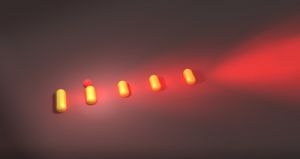Jun 6 2012
Javier Aizpurua, researcher at the Materials Physics Centre, a joint centre of the CSIC and the University of the Basque Country UPV/EHU, has designed a new model which describes the properties of optic nanoantennas at distances inferior to the nanometre by means of quantum mechanics, an advancement which completes the explanations based on classic physics equations which have been applied until now.
 Illustration of a nanoantenna powered by a cuantic point
Illustration of a nanoantenna powered by a cuantic point
The model, published in Nature Communications magazine, describes how nanoantennas are used more and more in optic applications in nanotechnology, controlling the direction in which light interacts with the material such as in miniature microscopes.
Metallic nanoparticles act as optic antennas, an effect which is achieved by means of the collective excitement of metal electrons, until now only described by the equations of Maxwell over a century ago.
Currently the most advance technology allows for a reduction in the separation between metallic nanoantennas, which has allowed for new properties that classic physics is unable to describe such as the transportation of electrons by means of the tunnel effect.
The model proposed by the Aizpurua Team, developed in collaboration with researchers from the Institute of Atomic and Molecular Collisions in Orsay (France) and the Laboratory for Nanophotonics in Houston (US), deals with, in a compact manner, the great quantity of electrons involved in the optic response of a nano structure and the quantum effects which appear at subnanometric distances.